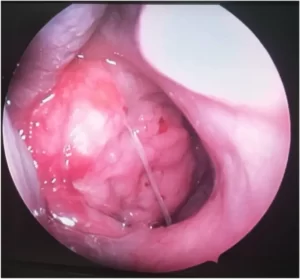Nose Cancer - Nasopharyneal Cancer (NPC)
Home | Services | Head And Neck | Nose Cancer – Nasopharyngeal Cancer (NPC)
What is nose cancer (nasopharyngeal cancer)?
Nasopharyngeal cancer, also known as NPC, is a type of cancer that forms in the nasopharynx, which is highest part of the throat — in or behind the nose.
Cancer occurs when cells become abnormal, grow uncontrollably and have the potential to spread to other parts of the body. These cells build up to form a lump or mass.
Nasopharyngeal cancer in Singapore usually affects adults between 35 and 55 years of age and is 20 to 30 times more common in persons of Chinese (especially Cantonese) descent than in other races. It is more frequent in males than in females. If the cancer is detected early, it is curable. In Singapore, it is the ninth most common cancer in men.
what is the nasopharynx and what does it do?
 The pharynx is the medical term for the throat. It has three parts:
The pharynx is the medical term for the throat. It has three parts:
- The nasopharynx (upper throat)
- The oropharynx (mid throat, including the tonsils)
- The hypopharynx (lower throat)
The nasopharynx is the highest part of the throat. It is the airway behind the nose and above the top of the mouth (soft palate). It connects the nose (nasal) cavity to the space behind the mouth (the oropharynx).
The nasopharynx allows air breathed into the nose to go down through the voice box (larynx) and into the lungs. It also allows phlegm (mucus) from the nose to be swallowed or spat out.
What causes Nose cancer / How do you get nose cancer?
The main causes of NPC are:
- Viruses: In particular the Epstein-Barr virus (EBV).
- Smoking: (cigarettes, cigars or pipes) or using smokeless tobacco (snuff and chewing tobacco) — If a person smokes or has smoked in the past they have a higher risk of getting nasopharyngeal cancer than someone who has never smoked.
Other factors that increase the risk of NPC are:
- Age: NPC generally develops in people aged >40 years.
- Male Sex: Men are about three times more likely than women to get NPC
- Being Southern Chinese: People from Southern China and South-East Asia are at higher risk.
- Family History: A first-degree relative diagnosed with NPC increases the risk of developing NPC
- Eating a lot of salt, cured fish and meat.
An endoscopic examination of the nose, pharynx and neck should be performed by an ENT specialist. If there is any suspicion of NPC, further tests will be recommended.
All patients with a first degree relative with NPC should have an examination yearly, as they are at higher risk of developing NPC in their lifetime.
Are there screening Blood tests for NPC?
Screening tests are available for NPC. These take the form of blood tests to assess the amount of Epstein-Barr virus (EBV) in the patient’s blood. However, these tests are often unreliable, as a high amount of EBV virus in the patient’s blood does not necessarily equate to having NPC. There are patients who have a high amount of EBV virus who never develop NPC in their lifetime.
What are Symptoms of Nose Cancer?
 The signs and symptoms of NPC depend on where the cancer is, its size and how far it has spread in the body. Common signs and symptoms include:
The signs and symptoms of NPC depend on where the cancer is, its size and how far it has spread in the body. Common signs and symptoms include:
- Nasal obstruction or stuffiness
- Frequent nose bleeds or blood in phlegm
- A blocked ear, decreased hearing or ringing in the ear, usually only on one side
- A lump in the neck
- Frequent headaches
- Numbness in the face
- Blurred or double vision
How is NPC investigated?
If there is a suspicion of NPC, it is imperative to assess the size of the cancer and whether it has spread to the lymph nodes in the neck or elsewhere in the body.
The following will need to be done:
- Documenting medical history including signs you may have noticed, any other health conditions, medications that you are taking, and whether you smoke or drink alcohol
- Performing a physical examination by feeling and looking inside your throat and neck
- Ordering diagnostic tests, which may include scans.
Not everyone will need to have every test for NPC. The most common tests for NPC are:
Nasoendoscopy
An examination of the nose and throat is imperative as part of the workup for NPC. This quick procedure involves inserting a small thin tube with a camera into the nose under local topical anaesthetic and can be done in the clinic.
Biopsy
This involves taking a piece of tissue (sample) either from the throat or from a lymph node in the neck, if it appears to be involved by the cancer. A pathologist then looks at the sample under a microscope to check for cancer cells. This is often the only sure way to tell if you have cancer. If the suspicious area can be safely accessed through the nose a sample for biopsy can be taken in the clinic. However, this may not be possible and some patients need to be asleep under a general anaesthetic for the biopsy. This is usually done as a day procedure.
Biopsies of the lymph nodes in the neck, if clinically suspicious, may also need to be performed. These are usually done using an ultrasound scan to make sure the needle is in the right spot.
Fine Needle Aspiration (FNA)
FNA is used when there is a lump (enlarged lymph node) in the neck that could have cancer cells in it. During the procedure, your doctor will take some cells from the lump using a needle. It may feel slightly uncomfortable during the biopsy.
Computed Tomography (CT) Scan
This uses X-rays to take pictures of the inside of the body. If a person has cancer, a CT scan can help the doctor to see where it is, measure how big it is, and if it has spread into nearby organs or other parts of the body.
Magnetic Resonance Imaging (MRI) Scan
This uses magnetic fields to take pictures of the inside of the body. This helps see how far a cancer has grown into the tissue around it.
Positron Emission Tomography (PET) Scan
This is a whole body scan that uses a radioactive form of sugar which can show if NPC has spread to the lymph nodes or elsewhere in the body.
How is Nasopharyngeal cancer Treated?
The most suitable treatment for NPC depends on many things including:
- The size and location of the cancer
- Whether the cancer has spread
- Patient factors (e.g. age, general health and treatment history)
- Treatments available
- Your preferences for treatment.
There are three types of treatment available for nasopharyngeal cancer.
- Radiation therapy
- Chemotherapy
- Surgery
Some patients may require a combination of the above. For the majority of patients, radiation therapy or a combination of radiation therapy and chemotherapy is the first line treatment for NPC. Surgery for NPC is uncommon as a first-line treatment because the area is difficult to get to and it is close to important nerves and blood vessels.
Surgery may be required if the cancer returns after previous treatment with radiation / chemotherapy; or if the initial response to first line treatment is suboptimal.
What is the Nasopharyngeal Cancer survival rate?
In 2020, an estimated 80,008 people worldwide died from NPC.
The 5-year survival rate tells you what percent of people live at least 5 years after the cancer is found. Percent means how many out of 100. The 5-year survival rate for all people with NPC in the United States is 61%.
However, survival rates depend on many factors, including the location of the tumor and if or where it has spread, called the stage.
If the cancer is located only in the nasopharynx (stage 1), the 5-year survival rate is 85%. If the cancer has spread to nearby tissues or organs and/or regional lymph nodes (stage 2/3), the 5-year survival rate is 71%. If there is distant spread to other parts of the body (stage 4), the 5-year survival rate is 49%.
Table Of Content
conditions We treat
- Thyroid nodules
- Cancer of the Thyroid
- Salivary Gland lumps
- Salivary Gland and/or Salivary Duct Stones
- Enlarged Cervical Lymph Nodes
- Cancers of the Head and Neck Region
- Nasopharyngeal Cancer (NPC)
- Lesions in the Mouth & Oral Cavity
Our Treatments
- Hemi / Total Thyroidectomy
- Salivary gland removal (submandibular / parotid gland)
- Removal of salivary duct stones
- Excision of Cervical Lymph Nodes
- Excision of Mouth & Oral Cavity Lesions








